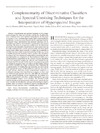Please use this identifier to cite or link to this item:
https://accedacris.ulpgc.es/handle/10553/75597
| Title: | Complementarity of discriminative classifiers and spectral unmixing techniques for the interpretation of hyperspectral images | Authors: | Li, Jun García Dópido, Inmaculada Gamba, Paolo Plaza, Antonio |
UNESCO Clasification: | 33 Ciencias tecnológicas | Keywords: | Discriminative Classification Hyperspectral Imaging Semisupervised Learning Spectral Unmixing |
Issue Date: | 2015 | Journal: | IEEE Transactions on Geoscience and Remote Sensing | Abstract: | Classification and spectral unmixing are two important techniques for hyperspectral data exploitation. Traditionally, these techniques have been exploited independently. In this paper, we propose a new technique that exploits their complementarity. Specifically, we develop a new framework for semisupervised hyperspectral image classification that naturally integrates the information provided by discriminative classification and spectral unmixing. The idea is to assign more confidence to the information provided by discriminative classification for those pixels that can be easily catalogued due to their spectral purity. For those pixels that are more highly mixed in nature, we assign more confidence to the information provided by spectral unmixing. In this case, we use a traditional spectral unmixing chain to produce the abundance fractions of the pure signatures (endmembers) that model the mixture information at a subpixel level. The decision on which source of information is prioritized in the process is taken adaptively, when new unlabeled samples are selected and included in our semisupervised framework. In this regard, the proposed approach can adaptively integrate these two sources of information without the need to establish any weight parameters, thus exploiting the complementarity of classification and unmixing and selecting the most appropriate source of information in each case. In order to test our concept, which has similar computational complexity as traditional semisupervised classification strategies, we have used two different hyperspectral data sets with different characteristics and spatial resolution. In our experiments, we consider two different discriminative classifiers: multinomial logistic regression and probabilistic support vector machine. The obtained results indicate that the proposed approach, which jointly exploits the features provided by classification and spectral unmixing in adaptive fashion, offers an effective solution to improve classification performance in hyperspectral scenes containing mixed pixels. | URI: | https://accedacris.ulpgc.es/handle/10553/75597 | ISSN: | 0196-2892 | DOI: | 10.1109/TGRS.2014.2366513 | Source: | IEEE Transactions on Geoscience and Remote Sensing [ISSN 0196-2892], v. 53 (5), p. 2899-2912, (Mayo 2015) |
| Appears in Collections: | Artículos |
SCOPUSTM
Citations
27
checked on Jun 8, 2025
WEB OF SCIENCETM
Citations
26
checked on Jun 8, 2025
Page view(s)
46
checked on Jan 24, 2024
Download(s)
137
checked on Jan 24, 2024
Google ScholarTM
Check
Altmetric
Share
Export metadata
Items in accedaCRIS are protected by copyright, with all rights reserved, unless otherwise indicated.
